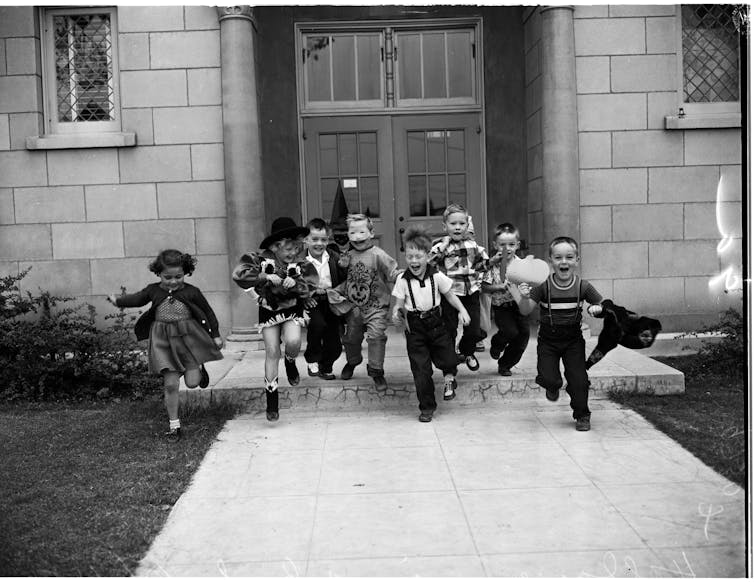

Curious Kids is a series for children of all ages. If you have a question you’d like an expert to answer, send it to curiouskidsus@theconversation.com.
How was Halloween invented? – Tillman, age 9, Asheville, North Carolina
“It’s alive!” Dr. Frankenstein cried as his creation stirred to life. But the creature had a life of its own, eventually escaping its creator’s control.
Much like Frankenstein’s monster, traditions are also alive, which means they can change over time or get reinvented. Built from a hodgepodge of diverse parts, Halloween is one such tradition that has been continually reinvented since its ancient origins as a Celtic pagan ceremony. Yet beneath the superhero costumes and bags of candy still beats the heart of the original.
The Celts lived in what’s now Ireland as far back as 500 B.C. They celebrated New Year’s Day on Nov. 1, which they called Samhain. They believed that leading up to the transition to the new year, the door between the worlds of the living and the dead swung open. The souls of the recently dead, previously trapped on Earth, could now pass to the underworld. Since they thought spirits came out after dark, this supernatural activity reached its peak the night before, on Oct. 31.
The Celts invented rituals to protect themselves during this turbulent time. They put on costumes and disguises to fool the spirits. They lit bonfires and stuck candles inside carved turnips – the first jack-o’-lanterns – to scare away any spirits looking for mischief. If all else failed, they carried a pocketful of treats to pay off wayward spirits and send them back on their way to the underworld.
Sound familiar?
Although focused on the dead, Samhain was ultimately for the living, who needed plenty of help of their own when transitioning to the new year. Winter was cold and dark. Food was scarce. Everyone came together for one last bash to break bread, share stories and stand tall against the dead, strengthening community ties at the time they were needed most.

When Catholics arrived in Ireland around A.D. 300, they opened another door between worlds, unleashing considerable conflict. They sought to convert the Celts by changing their pagan rituals into Christian holidays. They rechristened Nov. 1 “All Saints Day,” which today remains a celebration of Catholic saints.
But the locals held on to their old beliefs. They believed the dead still wandered the Earth. So the living still dressed in costumes. This activity still took place the night before. It just had a new name to fit the Catholic calendar, “All Hallows Eve,” which is where we got the name Halloween.
Irish immigrants brought Halloween to America in the 1800s while escaping the Great Potato Famine. At first, Irish Halloween celebrations were an oddity, viewed suspiciously by other Americans. As such, Halloween wasn’t celebrated much in America at the time.
As the Irish integrated into American society, Halloween was reinvented again, this time as an all-American celebration. It became a holiday primarily for kids. Its religious overtones faded, with supernatural saints and sinners being replaced by generic ghosts and goblins. Carved turnips gave way to the pumpkins now emblematic of the holiday. Though trick-or-treating resembles ancient traditions like guising, where costumed children went door to door for gifts, it’s actually an American invention, created to entice kids away from rowdy holiday pranks toward more wholesome activities.
Halloween has become a tradition many new immigrants adopt along their journey toward American-ness and is increasingly being exported around the world, with locals reinventing it in new ways to adapt it to their own culture.

What’s so special about Halloween is that it turns the world upside down. The dead walk the Earth. Rules are meant to be broken. And kids exercise a lot of power. They decide what costume to wear. They make demands on others by asking for candy. “Trick or treat” is their battle cry. They do things they’d never get away with any other time, but on Halloween, they get to act like adults, trying it on to see how it fits.
Because Halloween allows kids more independence, it’s possible to mark significant life stages through holiday firsts. First Halloween. First Halloween without a parent. First Halloween that’s no longer cool. First Halloween as a parent.
Growing up used to mean growing out of Halloween. But today, young adults seem even more committed to Halloween than kids.
What changed: adults or Halloween? Both.
Caught between childhood and adulthood, today’s young adults find Halloween a perfect match to their struggles to find themselves and make their way in the world. Their participation has reinvented Halloween again, now bigger, more elaborate and more expensive. Yet in becoming an adult celebration, it comes full circle to return to its roots as a holiday celebrated mainly by adults.
Halloween is a living tradition. You wear a costume every year, but you’d never wear the same one. You’ve changed since last year, and your costume reflects that. Halloween is no different. Each year, it’s the same celebration, but it’s also something totally new. In what ways are you already reinventing the Halloween of the future today?
Hello, curious kids! Do you have a question you’d like an expert to answer? Ask an adult to send your question to CuriousKidsUS@theconversation.com. Please tell us your name, age and the city where you live.
And since curiosity has no age limit – adults, let us know what you’re wondering, too. We won’t be able to answer every question, but we will do our best.
Linus Owens, Associate Professor of Sociology, Middlebury
This article is republished from The Conversation under a Creative Commons license. Read the original article.








You must be logged in to post a comment.